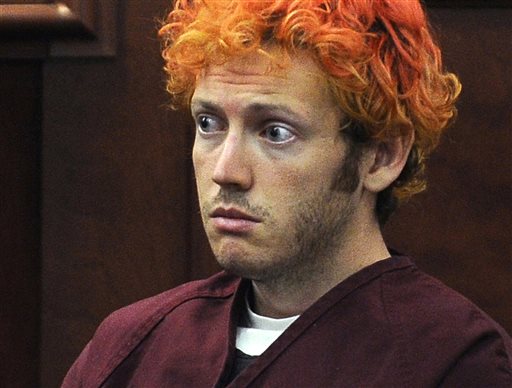Colorado shooter gets life term, jury fails to agree on execution

In this July 23, 2012, file photo, James Holmes, who is charged with killing 12 moviegoers and wounding 70 more in a shooting spree in a crowded theatre in 2012, sits in Arapahoe County District Court in Centennial, Colo. Jurors in the Colorado theater shooting case reached a decision Friday, Aug. 7, 2015, on whether Holmes should be sentenced to life in prison or the death penalty. The same jurors rejected Holmes’ insanity defense and convicted him of murder. AP, Pool, File photo
CENTENNIAL, Colorado — Colorado theater shooter James Holmes will be sentenced to life in prison without parole after a jury failed to agree Friday on whether he should get the death penalty for his murderous attack on a packed movie premiere.
The nine women and three men said they could not reach a unanimous verdict on each of the 24 murder counts. That automatically eliminates the death penalty for Holmes, who blamed his calculated murders of 12 people on mental illness.
Prosecutors argued Holmes deserved to die because he methodically planned the 2012 assault at a midnight screening of a Batman movie, even blasting techno music through ear phones so he wouldn’t hear his victims scream.
The verdict came as a surprise. The same jury rejected Holmes’ insanity defense, finding him capable of understanding right from wrong when he carried out the attack. It also quickly determined that the heinousness of Holmes’ crimes outweighed his mental illness in a prior step that brought them closer to the death penalty.
As the verdict was read, Holmes’ mother Arlene, who had pleaded for jurors to spare her son’s life, leaned her head against her husband’s shoulder and began sobbing. Tears broke out across the courtroom. In the back, Aurora police officers who responded to the bloody scene of Holmes’ attacks began crying.
Article continues after this advertisementThe defense countered that his schizophrenia led to a psychotic break, and that powerful delusions drove him to carry out one of the nation’s deadliest mass shootings. At least one juror agreed — a verdict of death must be unanimous.
Article continues after this advertisementJurors deliberated for about six and a half hours over two days before deciding on Holmes’ sentence.
They reached their decision after the judge granted their request earlier Friday to re-watch a graphic crime scene video taken immediately after the massacre. The 45 minutes of footage, played during the trial, shows 10 bodies lying amid spent shell casings, popcorn and blood.
There was never any question during the grueling, four-month trial as to whether Holmes was the killer. Holmes meekly surrendered outside the theater, where police found him clad head-to-toe in combat gear.
The trial hinged instead on the question of whether a mentally ill person should be held legally and morally culpable for an act of unspeakable violence.
It took jurors only about 12 hours of deliberations to decide the first part — they rejected his insanity defense and found him guilty of 165 felony counts.
The defense then conceded his guilt, but insisted during the sentencing phase that his crimes were caused by the psychotic breakdown of a mentally ill young man, reducing his moral culpability and making a life sentence appropriate.
The jury’s final decision came after days of tearful testimony from relatives of the slain.
The case could have ended the same way more than two years ago, when Holmes offered to plead guilty if he could avoid the death penalty. Prosecutors rejected the offer. But the victims and the public might not have ever learned in detail what was behind the shootings had the plea deal been accepted.
The trial — featuring a journal where Holmes had secretly described his murderous plans — provided a rare look inside the mind of a mass shooter. Most are killed by police, kill themselves or plead guilty. By pleading insanity, he dropped his privacy rights and agreed to be examined by court-ordered psychiatrists. Holmes told one that he had been secretly obsessed with thoughts of killing since he was 10.
His parents testified that he seemed a normal, affectionate child who withdrew socially in adolescence and became fascinated with science but did not seem abnormal. Holmes studied neuroscience hoping to understand what was happening to his mind. But it was when he moved from San Diego to Colorado to attend graduate school that his meltdown accelerated.
Holmes flunked out of his prestigious doctoral program at the University of Colorado and broke up with a fellow graduate student, the only girlfriend he’d ever had. He began to buy guns and thousands of rounds of ammunition and scouted out The Century 16 theater complex to learn which auditorium would offer the highest number of victims.
Holmes also constructed an elaborate booby-trap in his apartment a few miles away. It failed to explode, but it was designed to blow up and divert police and firefighters at the precise moment of his calculated attack.
Shortly after midnight on July 20, 2012, he slipped into the premiere of “The Dark Knight Rises,” stood before the capacity crowd of more than 400 people, threw gas canisters, and then opened fire with a shotgun, assault rifle and semi-automatic pistol.